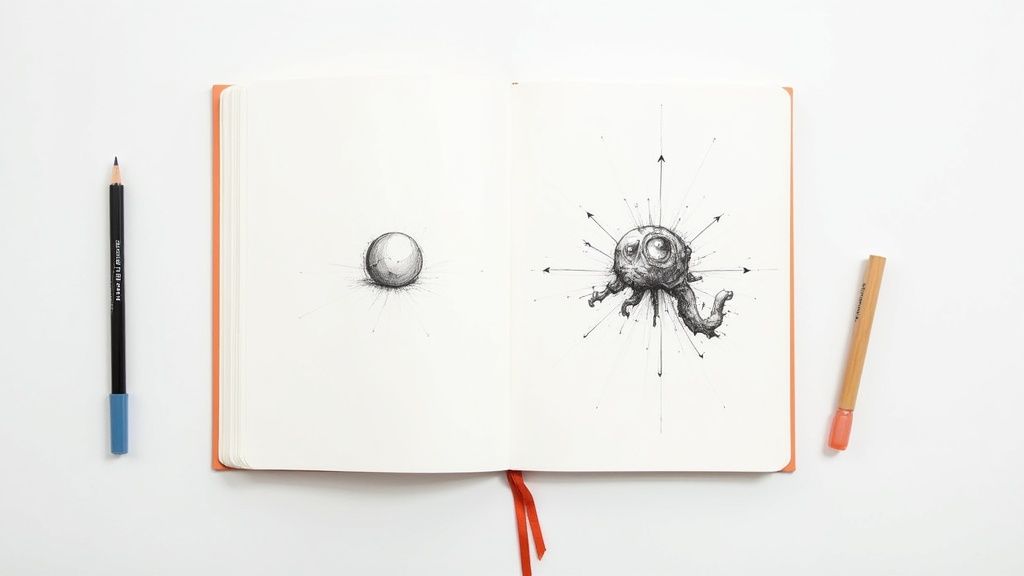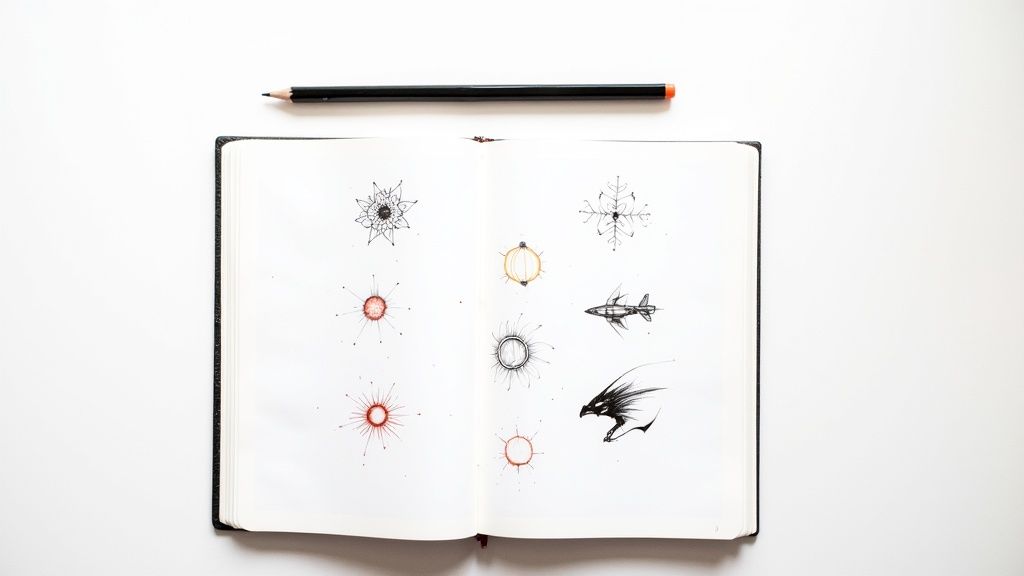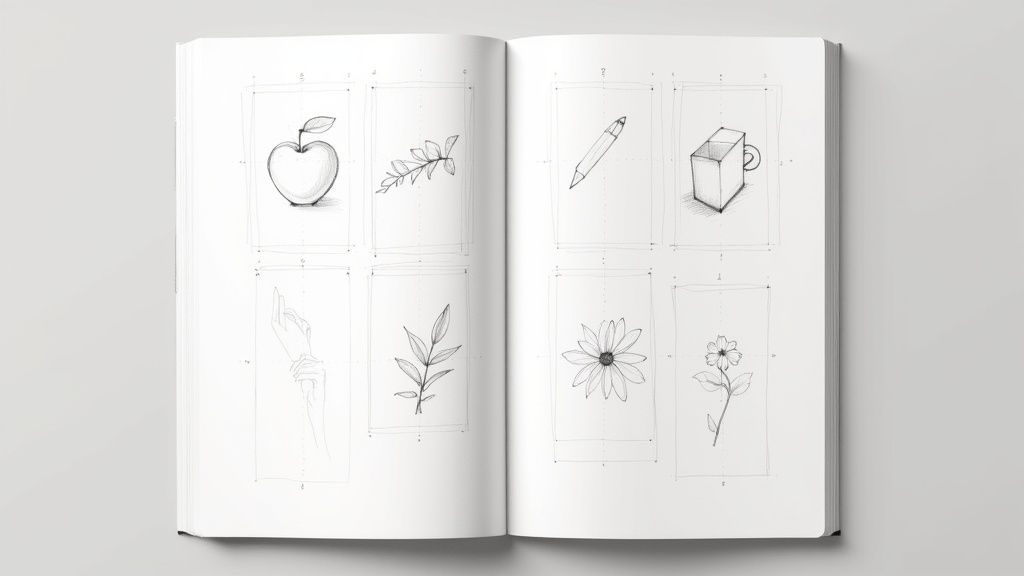Every artist, from the casual doodler to the seasoned professional, eventually hits a creative wall. You've perfected your character's eyes, but now every face looks the same. Your action poses feel stiff, and your color palettes have become repetitive. This isn't just an art block; it's a call for innovation. The world of anime art is vast and constantly evolving, moving far beyond the simple cel-shaded look many of us started with. To truly grow and develop a unique voice, you need to explore new techniques that challenge your habits and expand your visual library.
This guide is designed to be your roadmap out of creative stagnation. We're not just offering vague prompts; we are diving deep into 10 distinct, actionable techniques that professionals use to make their anime drawings dynamic, atmospheric, and unforgettable. From mastering the slick polish of modern soft-cell shading to integrating complex environmental storytelling, each section provides a fresh perspective. We'll break down core features, practical tips, and specific tools for each style. This will equip you with the methods to elevate your work from mere fan art to a portfolio-worthy masterpiece. Get ready to transform your approach and discover the next evolution of your artistic style.
1. Cel-Style (Traditional Animation) Technique
The cel-style technique is the bedrock of classic anime, responsible for the clean and iconic look seen in masterpieces from Studio Ghibli, Dragon Ball, and Sailor Moon. This method mimics the traditional animation process where artists painted characters on transparent sheets called "cels" and layered them over a background. The result is a sharp, polished aesthetic that makes anime drawings feel like they've been pulled directly from a professional production.
How to Achieve the Cel-Style Look
To replicate this style, focus on creating exceptionally clean line art. Many digital artists use vector-based software like Adobe Illustrator or Clip Studio Paint's vector layers to achieve perfectly smooth, scalable lines. Unlike sketchier styles, cel shading requires a deliberate and finished line art base before any color is applied.
Coloring is defined by flat, solid fills. Avoid complex gradients or soft-blended shading. Instead, shadows are treated as distinct, hard-edged shapes, often in a slightly darker and cooler tone than the base color. This simplicity is what gives cel-style its bold, graphic quality. For your own anime drawings, study color palettes from classic series to understand how they created mood with limited shades.
The following infographic highlights the three core components of mastering this technique.
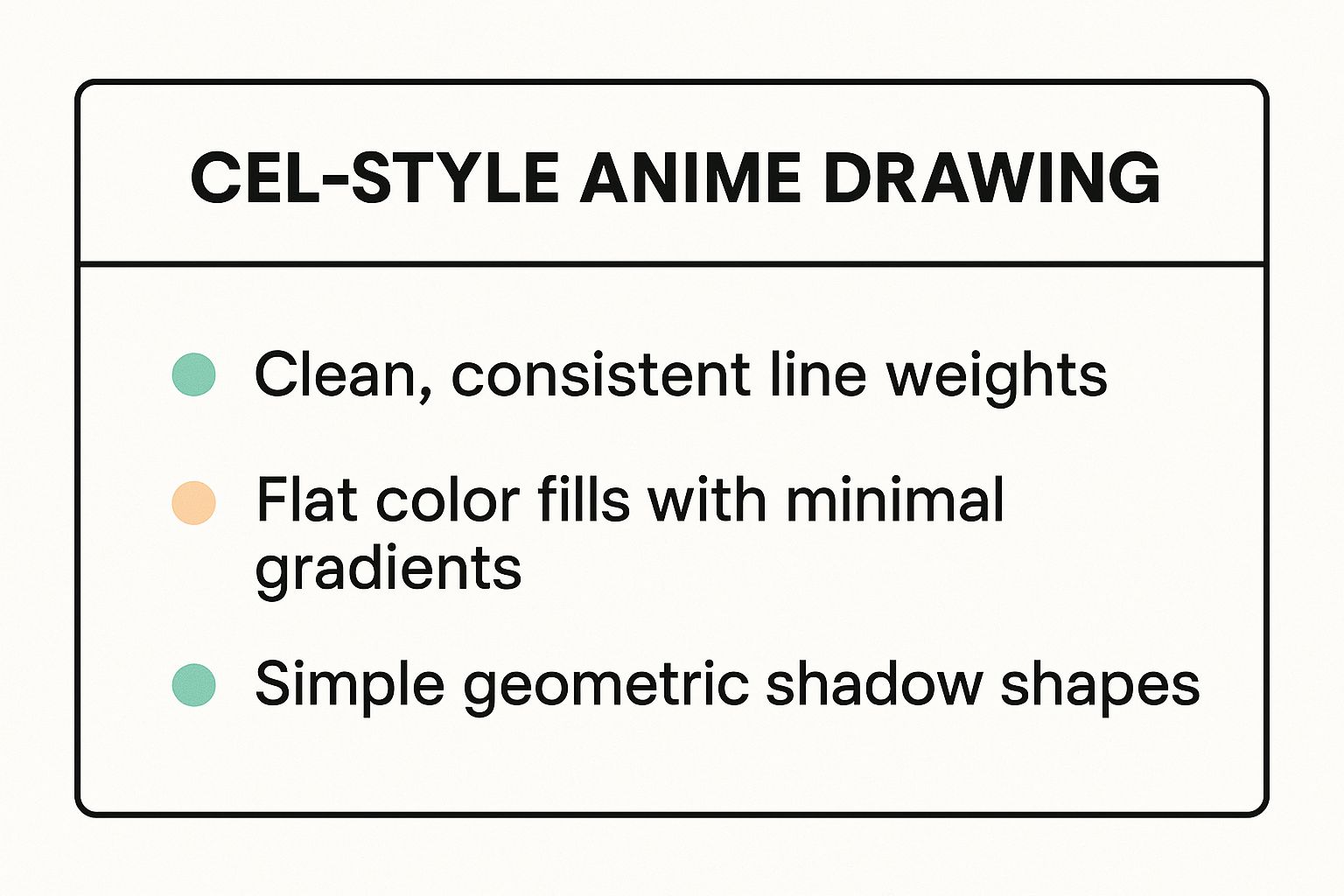
As the reference shows, the combination of consistent line work, flat colors, and geometric shadows is what produces the quintessential anime aesthetic.
2. Soft Cell Shading
Soft cell shading is a modern evolution of the classic cel-style, blending the clean, defined shadows of traditional anime with subtle gradients and softer edges. This hybrid technique adds a remarkable sense of depth, atmosphere, and realism to anime drawings without losing the stylized charm. Popularized by studios like Mappa and CoMix Wave Films in works like Attack on Titan, Demon Slayer, and Your Name, this style creates a more cinematic and emotionally resonant look.
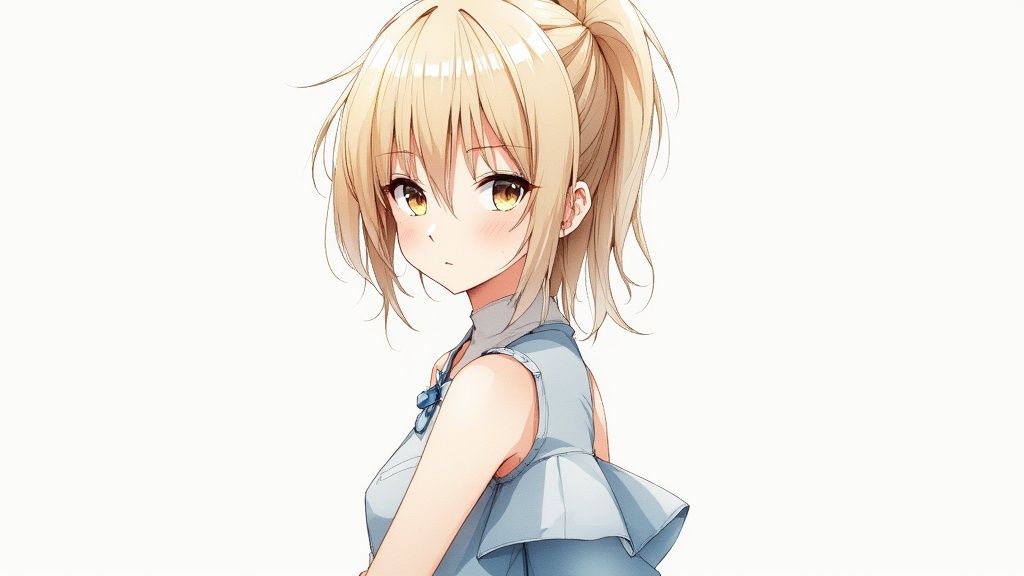
The core principle is to soften the transition between light and shadow. Instead of a hard line separating the base color from the shadow, a gentle gradient is introduced, often at the edge where the shadow begins. This creates a more natural and less graphic appearance, making characters and objects feel more three-dimensional and integrated into their environment. This approach is perfect for conveying delicate lighting, like the glow of a sunset or the soft ambiance of an interior scene.
How to Achieve the Soft Cell Shading Look
To master this technique, begin with your standard hard-edged shadow shape. Then, use a soft-edged tool like a soft round brush or an airbrush tool on a low opacity setting. Gently brush along the edge of the shadow to create a smooth transition into the base color. It’s crucial to keep these gradients controlled and subtle; over-blending can make the artwork look muddy and lose the crispness associated with anime.
Focus on where light would naturally diffuse. For instance, shadows on rounded surfaces like a face or arm would have softer edges than shadows cast by a sharp object. Studying how light interacts with different forms in real life will make your anime drawings more believable. Start practicing on simple geometric shapes like spheres and cylinders to understand how gradients wrap around a form before moving on to complex character illustrations. This method enhances visual appeal by adding a touch of sophisticated realism.
3. Digital Painting/Semi-Realistic Style
The Digital Painting/Semi-Realistic style elevates anime drawings into sophisticated, illustration-quality masterpieces. This hybrid approach merges classic anime features, such as large eyes and stylized proportions, with realistic rendering techniques. It emphasizes complex lighting, detailed textures, and painterly brushwork, creating a depth and polish often seen in high-end concept art, like that from Final Fantasy or Ghost in the Shell, and promotional movie artwork.
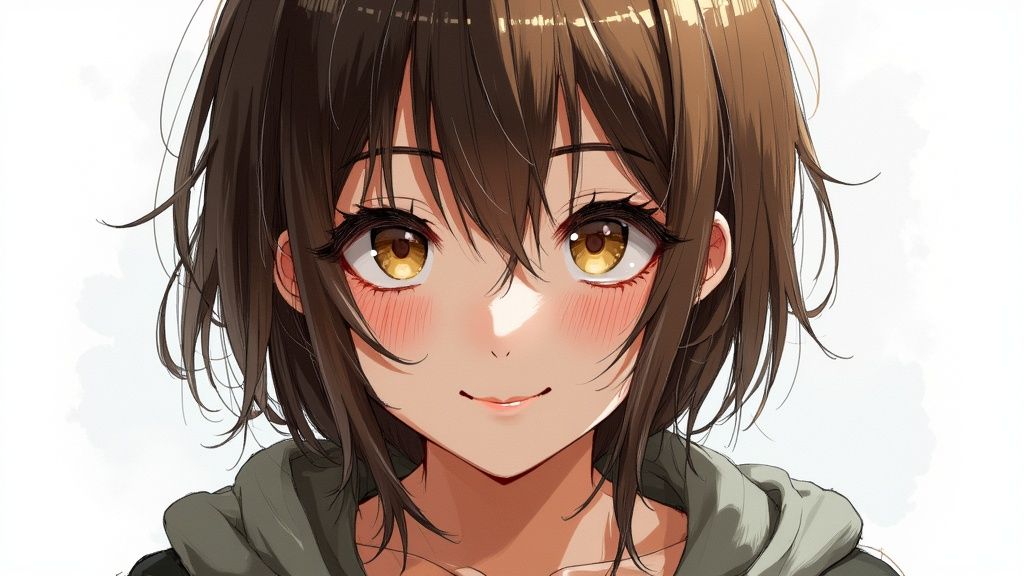
How to Achieve the Semi-Realistic Look
Success in this style starts with strong foundational drawing skills; realistic anatomy and perspective are crucial before adding anime characteristics. Instead of flat colors, you will build up tones gradually in layers, much like traditional oil painting. Study real-world lighting references to understand how light interacts with different surfaces, creating soft gradients, subsurface scattering, and bounce light.
Using a variety of digital brushes is key. Employ textured brushes to render materials like fabric, skin, and metal, giving your anime drawings a tangible, believable quality. Artists like Ilya Kuvshinov and Range Murata are masters of this technique, blending soft, blended shading with sharp, defined details to guide the viewer's eye. This approach is perfect for creating standalone illustrations that demand attention and showcase advanced artistic skill.
4. Chibi/Super Deformed Style
The Chibi style, also known as Super Deformed (SD), is a beloved and highly stylized form of anime drawing that emphasizes cuteness above all else. This technique involves radically altering a character's proportions, shrinking their body while enlarging their head to be anywhere from one-half to one-third of their total height. This creates an adorable, toy-like appearance perfect for comedic relief, merchandise like Nendoroid figures, or expressive LINE stickers.
How to Achieve the Chibi Look
Mastering Chibi anime drawings means abandoning realistic anatomy in favor of simplified, rounded forms. The key is exaggeration. Eyes should be exceptionally large and expressive, often taking up a significant portion of the face to convey powerful emotions. Details on clothing, hair, and accessories are simplified to avoid cluttering the small frame, focusing instead on recognizable shapes and colors.
Poses should also be exaggerated to match the art style. Dynamic, over-the-top gestures for happiness, anger, or surprise work incredibly well. For artists seeking inspiration, analyzing chibi segments from anime like Naruto or spinoffs such as Attack on Titan: Junior High provides excellent reference. Consistency is crucial; once you establish a head-to-body ratio, stick with it to create a cohesive look. Many artists find this style to be a fun and accessible entry point, and you can explore more Chibi/Super Deformed style concepts on DrawingList.com.
5. Line Art Variation Technique
The line art variation technique elevates anime drawings from flat and static to dynamic and professional. This sophisticated approach moves beyond simple, uniform black outlines by using varying line weights, styles, and even colors to create depth, emphasis, and visual interest. It is a hallmark of high-quality manga illustrations and professional character art, where every line serves a purpose.
How to Achieve Line Art Variation
To master this technique, think about how light and distance affect an object. Use thicker, bolder lines for the main contours of a character or for areas that are closer to the viewer. These heavy lines help ground the subject and draw immediate attention. Conversely, use thinner, delicate lines for internal details like hair strands, fabric folds, or facial features to avoid overwhelming the design. This contrast creates a clear visual hierarchy.
Varying your line pressure is key. In digital art, this means adjusting your tablet's pressure sensitivity settings to create a natural taper. A line should swell and thin as it curves around a form. You can also experiment with "colored holds," where you change the line art color to be a slightly darker shade of the filled area it contains. This softens the overall look, integrating the lines more seamlessly than stark black outlines and is often seen in professional anime promotional art. Many incredible anime drawings gain their professional polish from this one technique.
6. Screen Tone and Texture Application
The screen tone technique is a cornerstone of traditional manga art, offering a way to add depth, texture, and shading to black-and-white anime drawings. This method involves applying pre-patterned adhesive sheets with dots, lines, or gradients to artwork, creating the illusion of grayscale and texture without traditional shading. In digital art, this process is replicated with texture brushes and pattern libraries, allowing artists to achieve that classic, printed manga look that's rich with visual interest.
How to Achieve the Screen Tone Look
To effectively use screen tones, start with clean, finalized line art. This provides a clear boundary for applying your textures. In digital programs like Clip Studio Paint, you can easily drag and drop tone patterns onto specific layers or use a brush tool to "paint" them on. The key is to think about value and material. Use denser dot patterns for darker shadows and lighter patterns for subtle shading.
Consider where to apply textures for maximum impact. Screen tones are perfect for adding detail to clothing, creating atmospheric backgrounds, or indicating different materials like metal or fabric. Avoid overusing them; a common mistake is covering an entire drawing in one dense pattern. Instead, vary the tone densities and leave white space to guide the viewer's eye. Study how classic manga artists use this technique to build mood and define form in their anime drawings.
7. Dynamic Pose and Perspective Drawing
Dynamic pose and perspective drawing is a technique that breathes life and energy into static images, creating the illusion of movement and action. This approach is essential for any artist looking to capture the high-octane excitement found in shonen battle manga or action-oriented anime. It relies on extreme angles, foreshortening, and powerful poses to make your anime drawings feel cinematic and impactful, as if pulled from a key animation frame.
How to Achieve a Dynamic Look
To master this style, prioritize the principles of perspective and anatomy in motion. Begin by constructing your character around a "line of action," a single, fluid curve that dictates the overall energy and direction of the pose. This foundational line helps ensure the entire figure feels connected and energetic. Artists like Tite Kubo (Bleach) and Masashi Kishimoto (Naruto) are famous for using strong lines of action to create iconic, memorable poses.
Foreshortening, the technique of making an object appear closer than it is, is crucial for creating a sense of depth and drama. For example, drawing a character's fist larger as it moves toward the viewer creates a powerful, three-dimensional effect. To make this easier, practice with 3D modeling software or study reference photos of athletes in action. For even more inspiration, you can find a wide range of pose ideas for drawing on drawinglist.com to use as a starting point.
8. Atmospheric and Environmental Integration
Atmospheric and environmental integration elevates a simple character portrait into a complete, narrative-driven scene. This technique focuses on making an anime character feel like a natural part of their surroundings, where the environment itself sets the mood and tells a story. Think of the breathtaking, emotionally resonant landscapes in Makoto Shinkai's films or the lived-in worlds of Studio Ghibli, where character and setting are inseparable. The goal is to create anime drawings that are not just illustrations, but immersive experiences.
How to Achieve Atmospheric Integration
Begin your drawing process by planning the composition and lighting of the entire scene, not just the character. The environment should be considered first, as its light source, color palette, and weather will directly influence the character's appearance. For instance, a character standing in a rain-soaked city at night will have cool-toned highlights from streetlights and reflections on their clothes and skin. Using photo references for architecture, foliage, or cloud formations can provide a strong foundation for a believable setting.
To ensure a cohesive final piece, maintain a consistent color temperature across both the character and the background. If the scene is lit by a warm sunset, the character’s shadows and highlights should reflect those orange and pink hues. A common mistake is to render a character in neutral lighting and simply place them on a detailed background, which creates a disconnected "sticker" effect. By carefully balancing the level of detail and harmonizing the color scheme, your anime drawings will gain professional-level depth and emotional impact.
9. Mixed Media and Textural Enhancement
Mixed media is an innovative approach that elevates standard anime drawings by integrating real-world textures and patterns. This technique moves beyond clean, digital aesthetics to create artwork with a tactile, layered feel, reminiscent of art book illustrations or indie poster designs. By blending traditional anime line art and coloring with elements like paper grain, fabric swatches, or digital noise, artists can produce truly unique pieces that stand out.
How to Achieve a Mixed Media Look
Begin with a strong anime drawing as your foundation. Once your character and composition are complete, you can start layering textures. Use digital software like Clip Studio Paint or Procreate, which offer vast libraries of texture brushes and materials. You can also import high-resolution photos of textures like watercolor paper, concrete, or wood grain and use blending modes like "Overlay," "Multiply," or "Soft Light" to integrate them into your artwork.
The key is to maintain balance. A common mistake is overwhelming the drawing with too much texture, which can obscure the character and disrupt the composition. Start subtly, applying textures to specific areas like clothing, backgrounds, or magical effects. This ensures your anime drawings retain their core identity while gaining a rich, tangible quality that invites closer inspection. This method is perfect for artists wanting to develop a signature style that merges digital precision with organic charm.
10. Minimalist/Geometric Anime Style
The minimalist/geometric anime style is a modern interpretation that distills characters down to their core visual essence. This approach prioritizes strong silhouettes, clean lines, and simplified color palettes over intricate details, drawing heavy inspiration from graphic design principles. It is often seen in contemporary mobile game icons, simplified avatars, and sleek, modern fan art where immediate recognition and aesthetic clarity are key.
How to Achieve the Minimalist/Geometric Look
To create effective minimalist anime drawings, start by identifying the most recognizable features of a character, such as a unique hairstyle, a key accessory, or distinct eye shape. Reduce these elements to their basic geometric forms, such as circles, triangles, and rectangles. The goal is not to eliminate detail entirely but to simplify it in a way that preserves the character's identity while creating a clean, impactful composition.
Color plays a crucial role in this style. Instead of a full spectrum, limit yourself to a small, curated palette of two to four colors. Use these colors strategically to guide the viewer's eye and define form without relying on traditional shading. A strong, recognizable silhouette is paramount, ensuring the character is identifiable even without internal details. This approach is perfect for creating striking logos, icons, and other design-focused anime drawings. For more inspiration on this modern aesthetic, you can explore various aesthetic drawing ideas to see how simplicity creates powerful visuals. Learn more about aesthetic drawing ideas on drawinglist.com.
10-Style Anime Drawing Techniques Comparison
Technique | Implementation Complexity | Resource Requirements | Expected Outcomes | Ideal Use Cases | Key Advantages |
|---|---|---|---|---|---|
Cel-Style (Traditional Animation) | Intermediate | Moderate (vector software/tools) | Clean, polished classic anime look | Traditional anime, animation | Authentic style, easier animation |
Soft Cell Shading | Intermediate to Advanced | Higher (software with gradient tools) | More depth with soft gradients | Modern anime styles | Balanced detail, polished appearance |
Digital Painting/Semi-Realistic | Advanced | High (advanced painting software) | Highly detailed, sophisticated art | Portfolio pieces, promo art | Artistic expression, broad appeal |
Chibi/Super Deformed Style | Beginner to Intermediate | Low (any digital/traditional) | Cute, exaggerated, expressive characters | Cute/comedic content, stickers | Quick, charming, forgiving style |
Line Art Variation Technique | Intermediate | Moderate (line variation tools) | Dynamic, sophisticated line art | Manga, character sheets, promo art | Adds depth, visual interest |
Screen Tone and Texture Application | Intermediate | Moderate (specialized tools) | Manga-style texture and mood | Black & white art, manga | Professional manga appeal |
Dynamic Pose and Perspective Drawing | Advanced | High (3D refs, complex sketching) | Dramatic, action-packed visuals | Action scenes, game art | Engaging, skill-demonstrating |
Atmospheric and Environmental Integration | Advanced | High (complex software, 3D tools) | Immersive, mood-rich compositions | Movie scenes, environmental art | Story-rich, emotionally appealing |
Mixed Media and Textural Enhancement | Intermediate to Advanced | High (digital + traditional) | Unique, tactile-looking artwork | Indie art, experimental designs | Creative, hides flaws |
Minimalist/Geometric Anime Style | Intermediate | Moderate (vector/design tools) | Clean, modern, simplified anime designs | Logos, branding, minimalist art | Quick, trendy, easy to scale |
Your Next Masterpiece Awaits
You now have a toolkit of 10 powerful techniques ready to revolutionize your approach to anime drawings. We've journeyed from the foundational precision of traditional Cel-Style animation to the atmospheric depth of environmental integration and the bold simplicity of geometric design. Each method offers a unique pathway to not just complete a drawing, but to infuse it with a distinct personality and professional polish.
The central takeaway is this: artistic growth comes from intentional practice and fearless experimentation. Merely reading about soft cell shading or dynamic perspective is not enough. The real progress happens when you pick up your stylus or pencil and actively apply these concepts. Your ability to create compelling anime art is directly tied to the diversity of tools in your creative arsenal.
Turning Inspiration into Action
To truly benefit from this guide, your next steps should be deliberate. Don't let this newfound knowledge fade away. Instead, turn it into tangible skill.
- Select One Unfamiliar Technique: Choose the method that feels the most challenging or excitingly new. Dedicate your next drawing session exclusively to mastering its basics. If you always use hard-edged shading, spend a few hours practicing the subtle gradients of the digital painting style.
- Combine and Innovate: The true magic begins when you mix and match. Try pairing the clean, varied line art technique with the textured application of screen tones. What happens when you draw a Chibi character but place them in a highly detailed, atmospheric environment? This synthesis is where your unique style will emerge.
- Focus on Process, Not Perfection: Let go of the pressure to create a flawless masterpiece on your first attempt with a new technique. The goal is the expansion of your capabilities. Every attempt, whether it results in a portfolio piece or a valuable learning experience, makes you a more versatile and confident artist. These experiments are the building blocks of your future best work.
The distinction between an amateur and a seasoned artist often lies in their ability to consciously choose the right technique for the desired emotional impact. By mastering these different approaches to creating anime drawings, you gain the power to guide the viewer’s eye, set a specific mood, and tell a richer story with every line you draw. The canvas is blank, and you are more equipped than ever before. What will you create?
Ready to pair these powerful techniques with the perfect subject? Stop scrolling endlessly for inspiration and get a unique, actionable prompt in seconds. Drawing List offers a specialized Drawing Ideas Generator that provides endless character concepts, scenes, and scenarios perfect for practicing and refining your anime drawings.
